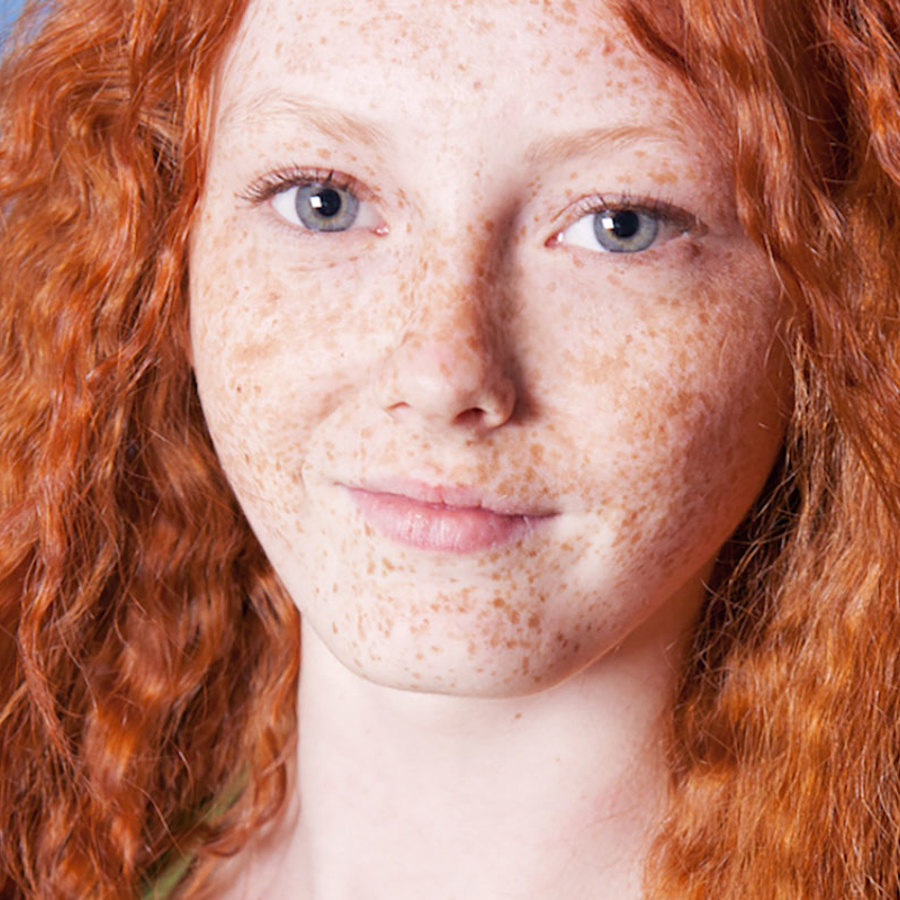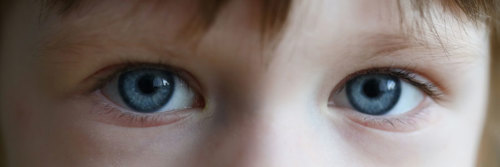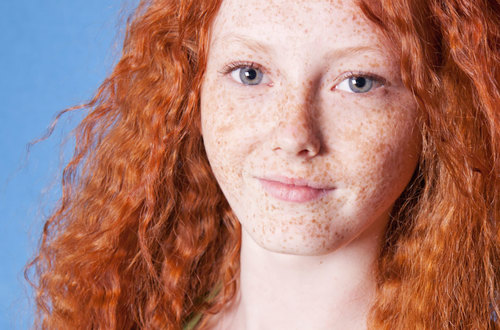
What will my children look like? Will they have freckles?
September 6, 2007

- Related Topics:
- Appearance,
- Freckles,
- Skin pigmentation,
- Pigmentation traits,
- Hair color,
- Eye color
A curious adult from Michigan asks:
What a great question! And a surprisingly hard one to answer. All of these traits are controlled by many genes, and it’s very hard to predict exactly what traits a person will inherit just based on their parents’ appearance. But we can try to make some educated guesses based on what we know about human genetics.
First off, you are right that your kids will probably end up with a darker skin color than yours. But, even though freckles are sometimes dominant, your kids probably won't have them.
This is because your husband most likely has genes that will keep them from showing up. As you may have guessed, the genetics of skin, hair and eye color are actually pretty complicated.
Out of the 20,000 genes we all share, at least a dozen are involved in pigmentation (the scientific word for coloration). And there are probably more genes that we don't know about yet. All of these genes work together to give a final color.
Some of these genes are stronger than other genes. They can overpower another gene and not let us see its effects.
We have two copies of most of our genes, one from each parent. Genes can also come in different versions (called “alleles”). And some of these versions are more dominant, or stronger, than others.
There's a whole lot going on here. Let’s look at a couple of examples to make all of this clearer. We'll start off with eye color.
Eye Color
To make things simple, let’s imagine that there is one gene that comes is two alleles: one for brown eyes and one for blue eyes. Imagine you get a blue eye allele from one parent and a brown eye allele from the other. Because brown is dominant over blue, you'll probably end up with brown eyes.
On the other hand, if you have two blue alleles, you’ll probably end up with blue eyes. This is because recessive traits will only show up if both copies are of the recessive allele.
But it's not quite that simple in reality. Green eyes, for example, come from a different gene. This gene has a dominant green version and a recessive blue version.
It turns out some alleles don’t just overpower the other allele of the same gene. Sometimes alleles from one gene can overpower entirely different genes as well!
The dominant brown allele of the first gene can overpower the dominant green allele of the second. So that person can have a dominant green allele in the second gene but still have brown eyes.
Let's back up and think about these two genes as paints. The first gene can paint in brown or blue. The second can paint in green or blue.
If you mix brown paint with green or blue, you get brown eyes. If you don't have brown, but you have green from the second gene, you have green eyes. If you don't have brown or green and have all four blue paints, you'll have blue eyes.
Now let’s talk about your child's possible eye color. You probably have only blue alleles in your two eye color genes. But, since blue or green eyes are rare in India, it’s likely that your husband has two brown alleles in the first gene. If that's true, then he can only pass on brown alleles for the first gene, and all your children will have brown eyes.
But, what if he has a brown and a blue allele from the first gene? Then your kids could have blue, green, or even hazel eyes. And the chances could be as high as 50% for a color other than brown.
And to make it even more complicated: I’ve only mentioned 2 genes for eye color, but there are probably a lot more than that! That makes it hard to predict perfectly.

Skin color
Believe it or not, eye color is the easy trait. There are even more genes that contribute to other types of pigmentation. Let’s look at skin color and freckles next.
Last year a new pigmentation gene called “golden” was discovered in zebrafish. This gene comes in two alleles – light and dark. Two copies of the light allele gives zebrafish a lighter color.
We humans have our own version of the “golden” gene. And it comes in a dark and a light allele too. Almost all people of African, Asian or Native American descent have two copies of the dark allele.
You can probably guess who has two copies of the light allele. That's right, people of European descent.
Now of course, this gene can't be the whole story: there’s a wide range of skin tones between people of Afrian and Asian descent. Two people who both have two copies of the dark version can still have a big difference in skin tone. Other genes must be involved too.
But let's look at the golden gene for now. In people, it looks like having both a light and dark allele gives a skin color somewhere in the middle. This is one reason why multi-racial children often have a skin tone that’s somewhere in between their parents’.
From this we’d predict that your kids would have a color somewhere between yours and his. But hold on … it might not be so simple in your case. Many people from India have a copy of the dark and the light allele.
You probably carry two light alleles and will pass down only a light allele. Your husband might carry a light and a dark allele. If he carries the light allele and passes that down, your children could have a somewhat lighter skin tone. If he carries the dark allele and passes that down, your children might have a more medium skin tone.
And like I said, there are definitely many more genes that contribute to skin pigmentation, most of which we don’t know about yet. What this means is that your child might end up with dark skin, but they could also end up with lighter skin than expected. And there may even be a small chance for freckles. Let's see why.

Freckles
The main freckle gene in people of European descent is called MC1R. MC1R actually comes in lots of different alleles. Some of these alleles are pretty strong and can cause freckles if a person has just one copy. Other alleles are not as strong and need two copies to make freckles.
But all of this can only happen with light skin color. People with darker skin color genes will probably not have freckles even if they have a freckling gene.
Again, let's think about paints. This time we have a skin color paint that comes in a brown (dark) version and a pale (light) version. We also have someone who will splatter on brown spots some of the time to make freckles.
If someone has the brown paint, it doesn’t matter if they get splattered or not. The brown spots will be hidden by the brown paint.
At least, this is the way we think it works. There are a couple of wrinkles that make things a bit more complicated.
First off, the freckle versions of the MC1R gene are pretty rare in populations outside of Europe. This means scientists haven’t studied a lot of cases of freckles from MC1R combined with the darker skin tones. The lack of MC1R freckles in most of the world's population suggests that most people in the world won’t get freckles. But we don’t know this for sure. As more people from around the world have kids together, we'll be able to better figure this out.
I know, enough already! Will my kids have freckles? Probably not, but I can think of one way they might, if only a few genes are involved. Imagine your husband has a light version of the skin color gene and you have the kind of freckle gene where you only need one copy to get freckles.
If you pass the freckle gene and your husband passes the light colored gene, then you may end up with a freckled child. Your child will get splattered with brown paint on a pale background.
Notice, though, that I said if there were only two genes involved. If your husband has another dark skin gene, that would probably be dominant over the freckle gene.

Hair color
And we haven’t even tackled hair color yet. We don’t really understand it very well, but one thing we can say is that your children probably won't have red hair (click here to learn why). Most likely they'll have a light to medium brown color (click here to learn more).
As we discussed, there are lots of genes involved in making us look the way we do. They can all influence skin, hair, and eye color, and especially freckles, in so many interesting ways. Who thought it would be so complicated?!

Author: Nanibaa’ Garrison
When this answer was published in 2007, Nanibaa’ was a Ph.D. candidate in the Department of Genetics, studying the genetics of human pigmentation in Greg Barsh’s laboratory. Nanibaa’ wrote this answer while participating in the Stanford at The Tech program.
 Skip Navigation
Skip Navigation
